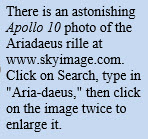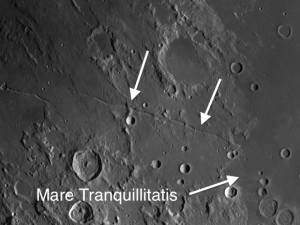 The week of June 3-9 takes us from New Moon to Lunar Day 7. This week we will highlight Rima Ariadaeus (the Ariadaeus Rille) viewable on Sunday evening, Lunar Day 7.
The week of June 3-9 takes us from New Moon to Lunar Day 7. This week we will highlight Rima Ariadaeus (the Ariadaeus Rille) viewable on Sunday evening, Lunar Day 7.
Rima Ariadaeus: [NE/J11] The best place to see rilles on the Moon is in the area just west of Tranquillity. Here you will find a remarkably varied collection, to wit, Ariadaeus, Hyginus (two of the best-known rilles on the Moon) and Triesnecker. We’ll start with Rima Ariadaeus tonight. The other two may still be hidden behind the terminator.

 When the terminator is close, Rima Ariadaeus is an enjoyable target even for small telescopes. It is a classic example of a graben, an elongated depression between two parallel fault lines where the ground in between has fallen away. If you have at least a 4″ telescope with good optics and steady seeing you will just be able to make out that the fault lines have pulled apart and the ground in between has sunk. (This is a challenge; Ariadaeus is a shade over two arc-seconds wide.) The rille appears to be broken in a few places, indicating that the lunar terrain has shifted since it was created, and there is a shunt on its western end connecting it to Rima Hyginus.
When the terminator is close, Rima Ariadaeus is an enjoyable target even for small telescopes. It is a classic example of a graben, an elongated depression between two parallel fault lines where the ground in between has fallen away. If you have at least a 4″ telescope with good optics and steady seeing you will just be able to make out that the fault lines have pulled apart and the ground in between has sunk. (This is a challenge; Ariadaeus is a shade over two arc-seconds wide.) The rille appears to be broken in a few places, indicating that the lunar terrain has shifted since it was created, and there is a shunt on its western end connecting it to Rima Hyginus.
WHAT’S HOT IN SPACE:
Jupiter’s South Equatorial Belt appears to be pulling material from the Great Red Spot in an event that’s visible in small scopes. A massive section of the Great Red Spot is peeling off of the East side!
The Beehive Cluster, M44, is an open cluster in Cancer. The stars are not resolvable with the naked eye so it remained a mystery until Galileo turned his telescope on it and discovered what it really was. Greek sailors knew that if you can’t see the Beehive Cluster on a clear moonless night, the next day would bring bad weather. The Beehive is viewable with no Moon in the sky on Monday night, or after 10:00 PM on Tuesday. If you have dark skies, see if you can spot it. If not, will the next day bring bad weather?
======================
It is highly recommended that you get a copy of Sky and Telescope’s Field Map of the Moon, the very finest Moon map available for use at the telescope. It is available for $10.95 at www.skyandtelescope.com and on Amazon. All features mentioned in this blog will be keyed to the grid on the Field Map and will look like this: Plato: [NW/D9]
Credits:
Courtesy of Gray Photography of Corpus Christi, Texas
Lunar photos: NASA / USGS / BMDO / LROC / ASU / DLR / LOLA / Moon Globe. Used by permission
- Rupes Cauchy: A Best Known Fault on the Moon - July 22, 2024
- Moon Crater Schickard – Crater Floor has Stripes - July 15, 2024
- Moon Craters Langrenus and Vandelinus - July 8, 2024